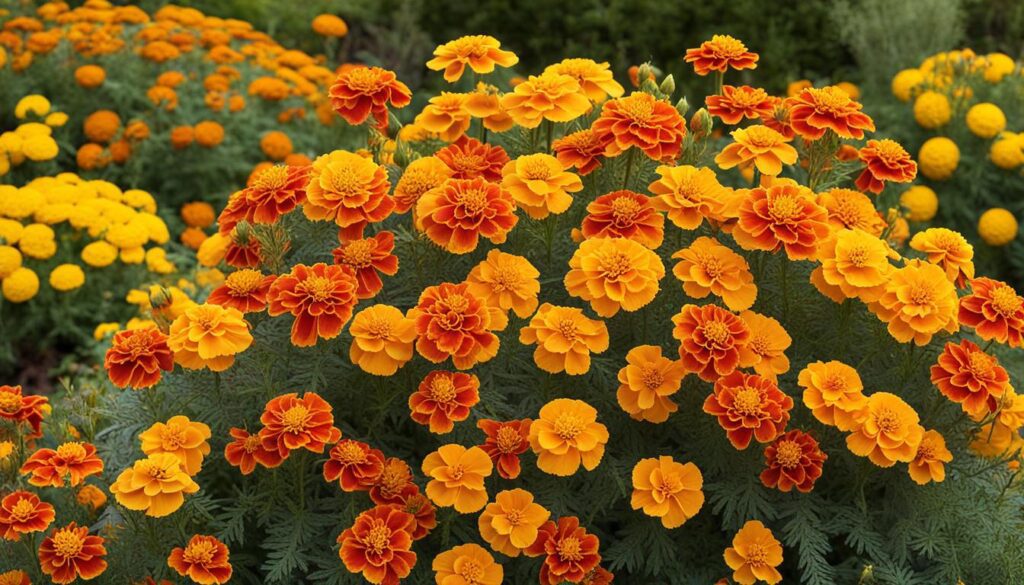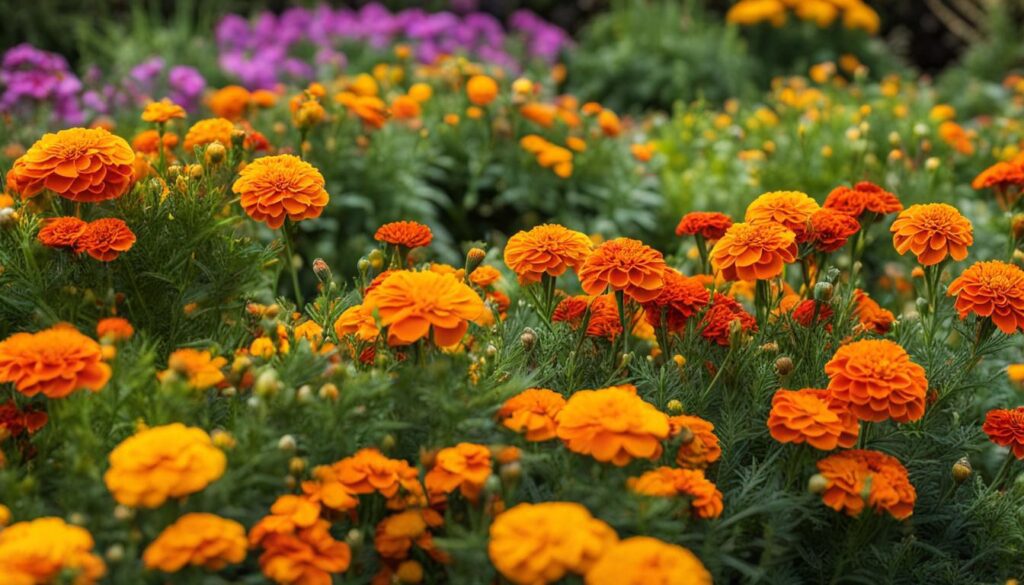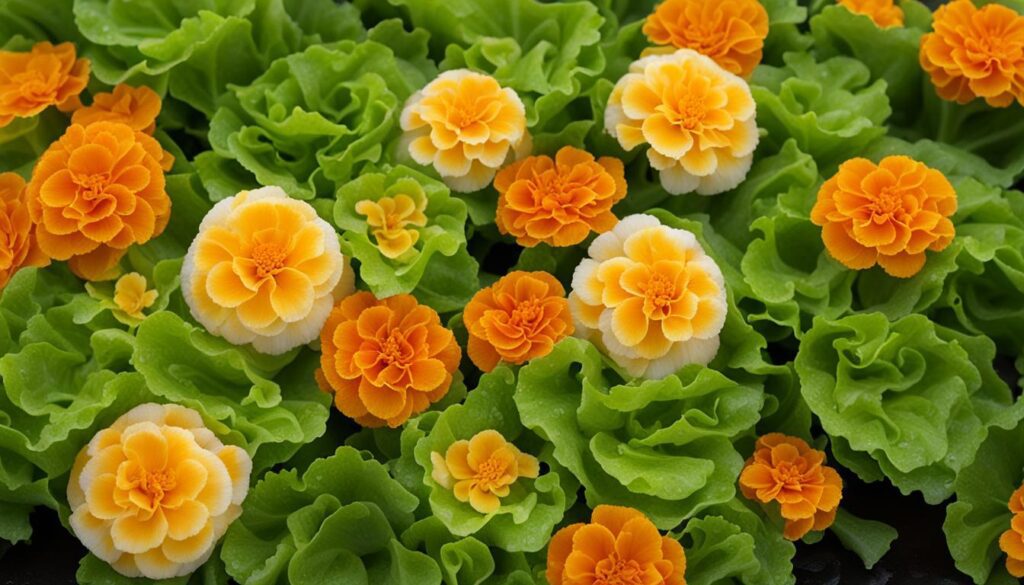Marigolds are popular flowers that can be grown as either annuals or perennials depending on the climate. They are easy to grow and come in various types, including French, African, and Signet marigolds. Marigolds are known for their ability to repel pests and attract pollinators. When making gardening decisions, it’s important to understand whether marigolds are annuals or perennials.
Key Takeaways:
- Marigolds can be grown as annuals or perennials depending on the climate.
- There are three main types of marigolds: French, African, and Signet.
- Marigolds have the ability to repel pests and attract pollinators.
- Gardening decisions should take into account whether marigolds are annuals or perennials.
- Understanding the characteristics of different marigold types is essential for informed gardening choices.
Different Types of Marigolds and Their Characteristics
Marigolds are a versatile and popular choice for gardeners, offering vibrant colors and beautiful blooms. There are three main types of marigolds: French, African, and Signet. Each type has its own unique characteristics, making them suitable for different garden preferences.
French Marigolds
French marigolds are known for their compact growing habit and abundance of flowers. They come in a variety of colors, including gold, orange, and red. French marigolds are medium-sized plants, typically growing up to 12 inches tall. They produce both double and single flowers, with the double flowers having a more intricate and layered appearance. French marigolds are a great choice for adding a burst of color to garden beds, borders, or containers.
African Marigolds
African marigolds are the largest type of marigolds, with tall and upright stems that can reach heights of up to 3 feet. They produce large double flowers in shades of yellow, orange, and gold. African marigolds are perfect for creating a bold and dramatic statement in the garden. Their impressive size and vibrant colors make them a focal point in flower beds and borders. These marigolds are also popular choices as cut flowers due to their long stems and showy blooms.
Signet Marigolds
Signet marigolds are the smallest type, growing up to 10 inches tall. They have a mounding growth habit and produce small, single-petaled flowers in shades of yellow, orange, and red. Signet marigolds have a delicate appearance and a subtle fragrance. What sets them apart from other marigolds is their edible flowers, which have a slightly spicy flavor. Signet marigolds are great for adding color to containers, rock gardens, or as borders along garden paths.
Understanding the different types of marigolds and their characteristics allows you to choose the ones that best suit your gardening needs. Whether you prefer the compact and colorful French marigolds, the showy and tall African marigolds, or the charming and edible Signet marigolds, these flowers are sure to bring vibrancy and beauty to your garden.
Growing Marigolds: Tips and Techniques
When it comes to growing marigolds, there are a few key tips and techniques that can help ensure their success in your garden. Whether you’re planting them in garden beds or containers, it’s important to provide the right conditions for these vibrant flowers to thrive.
First and foremost, marigolds love the sun. They require full sun exposure to reach their full potential, so be sure to choose a location in your garden that receives at least 6-8 hours of direct sunlight each day. This will help the plants develop strong stems and produce an abundance of flowers.
When planting marigolds in garden beds, make sure the soil is well-draining to prevent waterlogged roots. You can improve drainage by adding organic matter, such as compost or well-rotted manure, to the soil before planting. This will also provide essential nutrients for the plants to thrive.
Spacing is another important consideration when growing marigolds. Give each plant enough room to grow and spread out their foliage. The spacing requirements will depend on the specific type of marigold you’re growing, with larger varieties like African marigolds needing more space due to their height.
| Marigold Type | Spacing |
|---|---|
| French Marigolds | 8-10 inches apart |
| African Marigolds | 12-18 inches apart |
| Signet Marigolds | 6-8 inches apart |
Feeding and watering marigolds is relatively low-maintenance. These plants don’t require heavy fertilization, as too much nitrogen can actually result in excessive foliage growth at the expense of flowers. A balanced, all-purpose fertilizer applied during planting is usually sufficient.
Deadheading, or removing spent flowers, is important for encouraging continuous blooming. This helps redirect the plant’s energy towards producing new blooms rather than producing seeds. Simply pinch off the faded flowers to keep your marigolds looking fresh and vibrant throughout the growing season.
Edible and Cultural Significance of Marigolds
Marigolds, known for their vibrant colors and pleasant fragrance, have more to offer than just beauty. Contrary to popular belief, marigold flowers are actually edible and can be used in various culinary applications. Their petals, which range in color from bright yellow to orange, can be sprinkled on salads, brewed into teas, or used as a garnish for desserts. Marigolds are not only visually appealing but also add a unique flavor profile to dishes, with hints of citrus and spice.
Edible Marigold Recipes to Try:
- Marigold Infused Olive Oil: Combine marigold petals with extra virgin olive oil in a glass jar. Let the mixture infuse for a few weeks, then strain out the petals. Use this aromatic oil as a dressing or drizzle it over fresh bread.
- Marigold Tea: Steep a handful of marigold petals in hot water for a soothing and fragrant herbal tea. Add honey or lemon for extra flavor.
- Marigold Flower Cupcakes: Decorate cupcakes with whole marigold flowers for an eye-catching and edible centerpiece. Make sure to use pesticide-free flowers sourced specifically for culinary purposes.
“Marigolds have long been used in traditional medicine for their antimicrobial and anti-inflammatory properties. They are rich in antioxidants, vitamins A and C, and have been consumed for centuries to promote digestive health and boost the immune system.”
Aside from their edible qualities, marigolds hold cultural significance in various traditions around the world. In Mexican culture, marigolds play a prominent role in the celebration of Dia de los Muertos (Day of the Dead). These vibrant flowers are used to decorate altars and gravesites as offerings to deceased loved ones. Marigolds are believed to guide the souls of the departed back to their families during this special time. Their bright colors are thought to attract and welcome departed spirits, symbolizing the cycle of life and death.
Furthermore, marigolds are valued as companion plants in gardening due to their ability to deter pests and attract beneficial insects. They release natural compounds that repel aphids, nematodes, and other harmful insects, making them a popular choice for organic gardening. Additionally, marigolds attract bees, butterflies, and other pollinators, enhancing biodiversity in the garden.
| Cultural Significance | Edible Uses | Companion Plant Benefits |
|---|---|---|
| Symbolizes the journey of souls in Mexican culture | Petals can be used in salads, teas, and as dessert garnish | Repels pests and attracts beneficial insects |
| Used to decorate altars during Dia de los Muertos | Marigold-infused oil adds flavor to dishes | Natural pest control for organic gardening |
| Whole marigold flowers for decorative purposes | Enhances biodiversity by attracting pollinators |
Are French Marigolds Different from Regular Marigolds in Terms of their Growth Cycle?
French marigolds, though often mistaken for regular marigolds, possess distinct characteristics. Known for their vibrant colors and compact size, the beauty of French marigold perennials lies in their ability to bloom continuously throughout the growing season. These lovely flowers thrive under full sun and have a relatively short growth cycle, making them a popular choice for gardeners who desire a splash of color in their landscapes.
Conclusion
Marigolds are versatile and beautiful flowers that can be grown as annuals or perennials. Understanding the different types of marigolds and their characteristics is essential for making informed gardening decisions.
Whether you choose French, African, or Signet marigolds, they all offer unique benefits and can add color and vibrancy to your garden. French marigolds are compact and produce eye-catching flowers, while African marigolds impress with their tall stature and large blooms. Signet marigolds, on the other hand, are perfect for smaller spaces and even have edible flowers.
What’s more, marigolds have more to offer than just their beauty. Their edible qualities make them a delightful addition to culinary creations, and their cultural significance in events like the Day of the Dead adds a touch of tradition to your garden. Additionally, they act as companion plants, warding off pests and attracting beneficial insects.
Whether your goal is to brighten up your garden or explore the culinary and cultural possibilities of marigolds, these versatile flowers are definitely worth considering. So, get ready to create a vibrant and meaningful garden with marigolds as your companions.
FAQ
Are marigolds annuals or perennials?
Marigolds can be grown as either annuals or perennials depending on the climate.
What are the different types of marigolds and their characteristics?
The three main types of marigolds are French, African, and Signet marigolds, each with their own unique characteristics.
How should I grow marigolds?
Marigolds thrive in full sun and should be planted in garden beds, except for Signet marigolds which can be grown in containers. They require well-draining soil and proper spacing. Deadheading and staking may also be necessary for optimal growth.
Can marigold flowers be eaten?
Yes, marigold flowers are edible and can be used in culinary applications. They are high in carotenoids and can even be used to create natural food colorings.
Do marigolds have cultural significance?
Yes, marigolds have cultural significance, particularly in Mexican traditions such as Dia de los Muertos (Day of the Dead) where they are used to decorate altars and symbolize the journey of souls.












